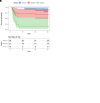Impact of Onset Time, Number, Type, and Sequence of Extrahepatic Organ Failure on Prognosis of Acute-on-chronic Liver Failure
- PMID: 38426199
- PMCID: PMC10899869
- DOI: 10.14218/JCTH.2023.00379
Impact of Onset Time, Number, Type, and Sequence of Extrahepatic Organ Failure on Prognosis of Acute-on-chronic Liver Failure
Abstract
Background and aims: The impact of the characteristics of extrahepatic organ failure (EHOF) including the onset time, number, type, and sequence on the prognosis of acute-on-chronic liver failure (ACLF) patients remains unknown. This study aimed to identify the association between the characteristics of EHOF and the prognosis of ACLF patients.
Methods: ACLF subjects enrolled at six hospitals in China were included in the analysis. The risk of mortality based on the characteristics of EHOF was evaluated. Survival of study groups was compared by Kaplan-Meier analysis and log-rank tests.
Results: A total of 736 patients with ACLF were included. EHOF was observed in 402 patients (54.6%), of which 295 (73.4%) developed single EHOF (SEHOF) and 107 (26.6%) developed multiple EHOF (MEHOF). The most commonly observed EHOF was coagulation failure (47.0%), followed by renal (13.0%), brain (4.9%), respiratory (4.3%), and circulatory (2.3%) failure. Survival analysis found that MEHOF or SEHOF patients with brain failure had a worse prognosis. However, no significant outcome was found in the analysis of the effect of onset time and sequence of failed organs on prognosis. Patients were further divided into three risk subgroups by the EHOF characteristics. Kaplan-Meier analysis showed that risk stratification resulted in the differentiation of patients with different risks of mortality both in the training and validation cohorts.
Conclusions: The mortality of ACLF patients was determined by the number and type, but not the onset time and sequence of EHOF. Risk stratification applicable to clinical practice was established.
Keywords: Acute-on-chronic liver failure; Brain failure; Extrahepatic organ failure; Prognosis.
© 2024 Authors.
Conflict of interest statement
The authors have no conflict of interests related to this publication.
Figures




Similar articles
-
Dynamic evaluation based on acute-on-chronic liver failure predicts survival of patients after liver transplantation: a cohort study.Int J Surg. 2023 Oct 1;109(10):3117-3125. doi: 10.1097/JS9.0000000000000596. Int J Surg. 2023. PMID: 37498133 Free PMC article.
-
Hepatic Encephalopathy Is Associated With Mortality in Patients With Cirrhosis Independent of Other Extrahepatic Organ Failures.Clin Gastroenterol Hepatol. 2017 Apr;15(4):565-574.e4. doi: 10.1016/j.cgh.2016.09.157. Epub 2016 Oct 5. Clin Gastroenterol Hepatol. 2017. PMID: 27720916
-
Impact of Hepatic and Extrahepatic Insults on the Outcome of Acute-on-Chronic Liver Failure.J Clin Exp Hepatol. 2017 Mar;7(1):9-15. doi: 10.1016/j.jceh.2016.10.006. Epub 2016 Oct 29. J Clin Exp Hepatol. 2017. PMID: 28348465 Free PMC article.
-
Acute-on-chronic liver failure in cirrhosis.Nat Rev Dis Primers. 2016 Jun 9;2:16041. doi: 10.1038/nrdp.2016.41. Nat Rev Dis Primers. 2016. PMID: 27277335 Review.
-
Acute-on-Chronic Liver Failure: Definition, Diagnosis, and Clinical Characteristics.Semin Liver Dis. 2016 May;36(2):109-16. doi: 10.1055/s-0036-1583202. Epub 2016 May 12. Semin Liver Dis. 2016. PMID: 27172351 Review.
References
LinkOut - more resources
Full Text Sources
